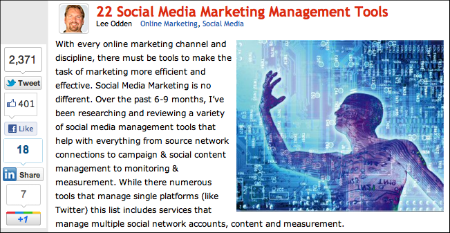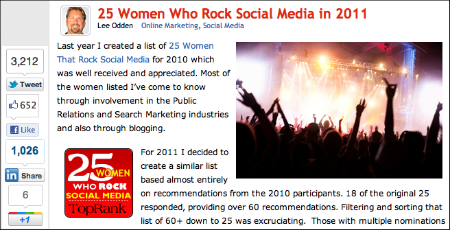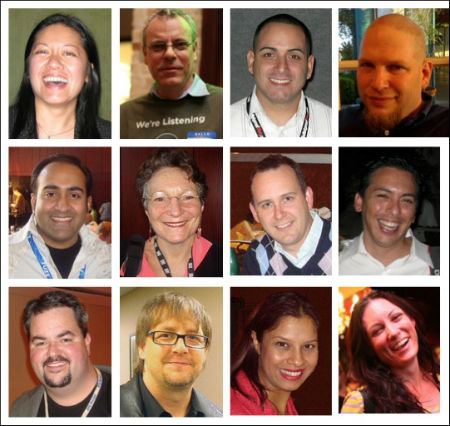 Being included on a popular list of credible resources like our own BIGLIST of top Marketing Blogs or one of the many other collections of useful resources posted online can feel pretty satisfying, validating the hard work many are putting in to their business blogs. Great lists get socially shared, linked, and emailed, giving those included quite a bit of valuable exposure. By association, the list publisher also gains value in terms of exposure, links, and a connection with list participants.
Being included on a popular list of credible resources like our own BIGLIST of top Marketing Blogs or one of the many other collections of useful resources posted online can feel pretty satisfying, validating the hard work many are putting in to their business blogs. Great lists get socially shared, linked, and emailed, giving those included quite a bit of valuable exposure. By association, the list publisher also gains value in terms of exposure, links, and a connection with list participants.
Curation is essential for sorting through the mass of data published online and with the closer integration of social media and search, each of us is becoming a mini-search engine for the benefit of our networks and for sites like Google and Facebook. Essentially, Google, Bing and even Facebook are just elaborate and massive content curators. The question is, how can we as marketers take advantage of mass curation and crowdsourcing for the benefit of our own online marketing?
One answer is to become a great content curator. Plenty of business websites and blogs are making lists this time of year, reflecting on the past 12 months as well as predicting what 2012 has in store. There’s something about seeing a sorted collection of useful information that motivates people to read and socially share. A well-sourced and thoughtfully-written list can evoke a strong emotion that inspires commentary and engagement.
Like them or not, credible, sorted lists and collections of resources are powerful blog content and social media marketing tools. Unfortunately, many marketers are overusing the same old tactics ala “link bait” for a quick hit and not looking at the longer term benefits or impact. Through trial and error, we’ve made the same mistakes but with good web and social media analysis, we’ve been able to make some great improvements.
Who doesn’t want to increase traffic and engagement in their blog and social media marketing programs? I thought so. Here are three types of curated lists and resource collections bloggers can use to efficiently create useful content that attracts, engages and inspires their readers to action.
Curated Resource Collections
Think of much needed resources in your industry. Are there tips, how-to’s, reports, examples, tools, events, networks, or something else that could be aggregated and made useful? Think about different formats including text, image, video, audio, or something interactive. Use bookmarking to save interesting things as you go vs. trying to create a list in a single effort. I have 20-30 categories of resources I add to every few days. Spread your resource collection effort over time and across your team when researching larger collections. You can also crowdsource them from your own social network.

Here are a few examples of the Resource Collections we’ve published that have attracted tens of thousands of links, visitors and by association, attention to our online marketing agency:
- List of of 100+ Blog & RSS Directories
- 100+ Search Marketing Resources
- 22 Social Media Marketing Management Tools
- 5 Reports on B2B Social Media Marketing & New Media Trends
- Free Tools for Social Media Optimization
- 5 Must Read Reports on Social Media & Public Relations
What exists in your industry that’s highly valued but not easy to find in one place? Bring those things together in a list. Also, think about what you can do to creatively involve your community with the sorting of the list. What can you do visually to make your collection stand out?
Curated Lists of People or Blogs
While you’ve seen many lists of the most popular individuals for a particular category (especially in the social media realm) on just about every blog online, they fact that many of them are arbitrary or playing industry celebrity favorites means there’s tremendous opportunity to do something unique and more interesting.

We’ve been active creating lists of people to recognize their contribution as well as crowdsourcing content from individuals into lists of tips for many of the 8 years this blog has been publishing online. Some of the more popular examples in terms of search traffic and links include:
- 2010, 2011 Women Who Rock Social Media
- What are the best UK Online Marketing Blogs?
- 10 Most Subscribed Search Marketing Blogs
- BIGLIST of SEO Blogs
Some of these lists are a one time effort, but some of them are annual, such as the Women Who Rock Social Media list. Qualitative lists inspire those included to help promote and with a collective effort more exposure to the list brings more attention to each individual. The key is for the list to be relevant, well sourced and written.
Crowdsourced Lists of Tips and Insights from Industry Experts
Another way to include disparate, useful resources into one collection is through crowdsourcing. By that I mean asking a group of subject matter experts the same question or similar questions and curating the results into one, topically specific (and keyword optimized) list. You could also make sure that when you interview industry experts, that some of the questions are the same same for all interviewees. Then you can re-purpose the different answers to single questions as a meeting of the minds post that brings together different, well-respected thought leadership in a single topic.

Here are a few examples of tapping a network of awesome people I’ve come to know for insight into topics that are consistent with our editorial plan:
- Must Read Social Media Marketing Tips from 25 Social Media Experts
- Social Media Strategy – A Definitive Guide from 44 Social Media Experts
- 10 Thought Leaders Share Their Definitions of Content Curation
When asking well known and influential people to contribute, be respectful of their time and make it easy to contribute. Don’t ask for them to write War and Peace. Ask one simple question via email and offer to capture it verbally over the phone/Skype if that works better. When you publish the curated collection of tips, be sure to give participants an individual (as in personalized/unique) heads up that the list is published as well as to thank them for their participation. Recognition is important to everyone, whether they’re well-known or just starting out.
Surely there are unrecognized people or resources in your industry. What or whom could you recognize in an original and thoughtful way that aligns well with your own unique selling proposition and key message? If your business sells Kindle Fire Cases, then couldn’t you curate a list of Kindle resources? Clever reasons to use a Kindle case? Book suggestions from Authors? Game, App or Movie reviews? Use a metaphor in your list title that includes target SEO keywords: Authors on Fire: Kindle Style, One the Case with Kindle Apps. They’re not a direct match, but that’s the art and science of SEO copywriting – a topic for another post.
Tips on Sourcing, Promoting, and Repurposing Curated Lists
As with any marketing endeavor, think about the purpose and intended outcome of your list first. What search keywords and social topics represent interests, needs, and goals of the influencers and end customers that you’d like to connect with? Pick a topic and stick to it.
Sourcing. As you understand your community, what are the unmet needs in information that you could satisfy? What unrecognized individuals or companies with powerful networks could be resources for, or included in the list? How will it fit in and complement your content marketing and social media strategy? Incidentally, I have an entire book dedicated to this topic coming out in March.
Creation. Put qualitative effort into creating your collection or list. Make it special, useful, and unique. Make it snarky or funny and by all means, make it shareable! Gimmicks are not nearly as important as quality and relevance to the community you’ll be promoting to. That said, you do need to think of what will make your collection promotable. Great content isn’t great until it’s consumed and shared.
Repurposing. Lists of things like people, books, reports, quotes, or just about anything can be repurposed as a PowerPoint on SlideShare or made into a video with bumper messages, narration, and music to be promoted on YouTube. If you’re smart about sourcing and making the collection promotable, then don’t just do it once. Plan on making the list annually, quarterly, or monthly.
Understand that with collections and lists, people and companies have an inherent desire to be included and recognized. At the same time, lists are exclusionary, so offer your readers an opportunity to add to the list you’ve created. Encourage them to participate and think about the group social needs, not just your own. A qualitative approach that focuses first on relevance of a collection to the community you’re promoting to will result in much better reach and engagement for you.
By the way, if you like this post, then you’re going to LOVE this book: Optimize. Published by Wiley, it will come out mid-March this year and is full of ideas, tips and insights.
A distant version of this article originally appeared on my Social Media Smarts column for ClickZ.


